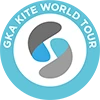The Kite-Surf discipline aims to find the most complete surfboard rider. The championship is contested over a series of pure wave events, pure strapless-freestyle and mixed format events, depending on the conditions. The success of the Kite-Surf tour has been that its format is able to adapt to a range of conditions, whether there are waves or not. Competition schedules are set months in advance, making it difficult to guarantee waves for a pure surfing contest.
In the pure wave events, riders are judged on their ability to surf the wave. Wave selection is one key element in the judges’ scoring criteria. Choosing the best waves gives the riders the greatest opportunity to showcase their skills, as it offers them the longest rides on the steepest faces.
Once on the wave, the judges award more points for the athlete’s commitment. That means making the riskiest turns in the wave’s critical section—just as it breaks—where it is at its steepest and most powerful. Snapping off the lip with the greatest verticality demands the most skill and is rewarded accordingly. The judges are also looking for flow and rail-to-rail surfing as the competitors link their turns all the way down the line.
The athletes can use the power of the kite to race around breaking “close out” sections of the waves until they open up again and they can continue their ride. This ability to link the wave’s sections and maximise the ride is another critical factor in the judge’s scoring. Riders can also add some aerial manoeuvres on the wave faces to increase the style factor.
In the absence of good waves, the discipline may be staged in a strapless-freestyle format, where the athletes are prohibited from using foot straps. Here the competitors perform tricks—jumps, rotations and kiteloops—off the small waves that act as take-off ramps. The athletes also use the power of their kites to help them get airborne.
The judges reward athletes for the height and distance they travel during their jumps. Scores are also given for the power of the trick and its technical difficulty, all of which increase the risk factor. The smoothness of the trick’s landing is another key component. In a bid to avoid repetitiveness and encourage variety to enhance the show, the tricks are divided up into different families. Strapless-Freestyle’s evolution has been heavily influenced by the Big Air Surfboard discipline.
The third, mixed format, is a combination of the two styles. The Race Director, in consultation with the Head Judge, will choose a mixed format when the waves are considered only “average”. Just as in the other Kite-Surf categories, competitors may get as many as 10 attempts. Here, a combination of their best wave rides and best trick scores, will count towards their heat total.
The male and female rider with the most points at the end of the season (allowing for any possible discarded score if there are four to six events) will be crowned World Champions.



